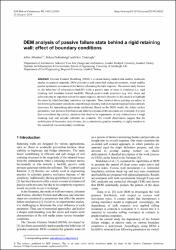| dc.contributor.author | Altunbaş, Adlen | |
| dc.contributor.author | Soltanbeigi, Behzad | |
| dc.contributor.author | Çinicioǧlu, Özer | |
| dc.date.accessioned | 2020-01-02T12:56:37Z | |
| dc.date.available | 2020-01-02T12:56:37Z | |
| dc.date.issued | 2019 | en_US |
| dc.identifier.citation | Altunbaş, A., Soltanbeigi, B. ve Çinicioǧlu, Ö. (2019). DEM analysis of passive failure state behind a rigid retaining wall: Effect of boundary conditions. İbrahim E. ve Tarantino A. (Ed.), 7th International Symposium on Deformation Characteristics of Geomaterials, IS-Glasgow 2019. Glasgow, United Kingdom, 26-28 June 2019. http://doi.org/10.1051/e3sconf/20199214012 | en_US |
| dc.identifier.isbn | 9782759890644 | |
| dc.identifier.issn | 2555-0403 | |
| dc.identifier.uri | http://doi.org/10.1051/e3sconf/20199214012 | |
| dc.identifier.uri | https://hdl.handle.net/20.500.12511/4869 | |
| dc.description.abstract | Discrete Element Modelling (DEM) is a virtual testing method that enables multiscale studies on granular materials. DEM provides a well-controlled testing environment, which enables precise systematic evaluation of the factors influencing the bulk response. The current study focuses on the behaviour of cohesionless backfills while a passive state of stress is simulated (i.e. rigid retaining wall translates toward backfill). Though particle-scale properties (e.g. size, shape and cohesion) play an important role on the macro response, the main objective in this study is to highlight the extent by which boundary conditions are important. Thus, identical dense packings are subject to the following boundary conditions: smooth/rough retaining wall and smooth/rough/periodic sidewalls (necessary for maintaining plain-strain conditions). Based on the DEM results, the failure surface geometries, wall pressure distribution and dilative response of the specimens are evaluated. It is seen that a curvilinear slip surface, similar to that observed in experiments, is only obtained once a rough retaining wall and periodic sidewalls are available. The overall observations suggest that the mobilisation of the passive state of stress, for a cohesionless granular assembly, is highly sensitive to the considered various boundary conditions. | en_US |
| dc.language.iso | eng | en_US |
| dc.publisher | EDP Sciences | en_US |
| dc.rights | info:eu-repo/semantics/openAccess | en_US |
| dc.rights | Attribution 4.0 International | * |
| dc.rights.uri | http://creativecommons.org/licenses/by/4.0/ | * |
| dc.subject | Retaining Walls | en_US |
| dc.subject | Discrete Element Modelling (DEM) | en_US |
| dc.subject | Various Boundary Conditions | en_US |
| dc.title | DEM analysis of passive failure state behind a rigid retaining wall: Effect of boundary conditions | en_US |
| dc.type | conferenceObject | en_US |
| dc.relation.ispartof | 7th International Symposium on Deformation Characteristics of Geomaterials, IS-Glasgow 2019 | en_US |
| dc.department | İstanbul Medipol Üniversitesi, Güzel Sanatlar Tasarım ve Mimarlık Fakültesi, Mimarlık Bölümü | en_US |
| dc.identifier.volume | 92 | en_US |
| dc.relation.tubitak | info:eu-repo/grantAgreement/TUBITAK/SOBAG/114M329 | |
| dc.relation.publicationcategory | Konferans Öğesi - Uluslararası - Kurum Öğretim Elemanı | en_US |
| dc.identifier.doi | 10.1051/e3sconf/20199214012 | en_US |




















